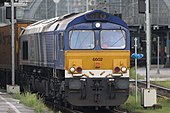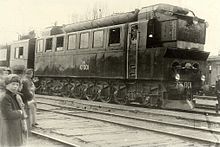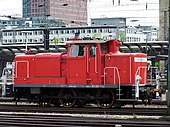Diesel locomotive
A diesel locomotive is a railroad traction vehicle that draws its drive power from one or more built-in diesel engines .
History of diesel locomotives
Historically, diesel locomotives were only developed after the steam and electric locomotives. The big problem of the first attempts with diesel engines for railway traction was the necessity to start the engine without load and to generate a power transmission to the driving axles on the rails only after the engine had started up .
After initial errors and attempts to start with friction clutches , as with trucks , and singular concepts (diesel compressed air locomotive with rod drive such as the Diesel-Sulzer-Klose thermal locomotive ), the diesel-electric drive initially turned out to be a useful solution, in which the Diesel engine drives a generator and the electricity is fed to the traction motors. This concept was first used by Yuri Lomonossow for a large mainline locomotive in the Ээл2 diesel locomotive used in the Soviet Union in 1924 .


This concept is still popular around the world today. Large parts of the freight train traction in North America as well as that of the Soviet Union were based on this. A locomotive with this technology in Europe for a long period of time at several railway companies is the NoHAB AA16 .
At the Deutsche Bundesbahn , the diesel locomotive was essentially only able to establish itself with hydraulic power transmission after the Second World War. This is based on the Föttinger clutch and the concept of the torque converter as well as the production engineering developments of companies such as Voith . In contrast to many railway companies abroad, the Deutsche Bundesbahn preferred medium-sized four-axle locomotives with a comparatively low weight of up to 80 tons. In this weight class, it achieved the breakthrough with the V 200.0 series . Because of the electrification of the main lines, there was no need for high performance diesel locomotives in West Germany. Individual six-axle diesel locomotives with a weight of up to 120 tons were only built as a development model. So came about:
- a copy of the V 300 ( Krauss-Maffei ML 3000 C'C ' , 1958),
- a copy of the V 320 ( Henschel DH 4000 , 1962),
- two copies of the 202 series ( Henschel-BBC DE 2500 , 1971/3),
- three copies of the 240 series (MaK-Krupp-ABB DE 1024, 1989).
At the Deutsche Reichsbahn the development was similar, but it was delayed. After the mainline locomotives of the DR series V 180 were manufactured, the locomotive industry concentrated on the construction of smaller diesel-hydraulic locomotives for shunting and light mainline service. The GDR imported large mainline locomotives on the basis of cooperation agreements within the framework of the Comecon . This is how diesel-electric six-axle large diesel locomotives from the Soviet Union of the classes 120 and 130/131/132/142 came to the GDR. The BR 130 machines and their successors were created especially for German conditions.

The development of diesel-hydraulic locomotives was carried out by Voith Turbo Lokomotivtechnik in Kiel until 2014. The Gravita and Maxima types were produced last . The current state of development are diesel-electric locomotives for freight traffic with over 4400 kilowatts of drive power.
In passenger transport in Germany , diesel locomotives have been more and more replaced by diesel- powered multiple units for several years ; only the transport of heavy express trains is still predominantly carried out with locomotives.
advantages and disadvantages
One of the advantages of diesel locomotives is that, unlike electric locomotives, they do not require expensive contact lines and, on the other hand, they do not have to be serviced as laboriously as steam locomotives in the depot before and after the journey . As a result, the number of diesel locomotives worldwide by railroad companies is higher than that of electric locomotives.
The disadvantages of a diesel locomotive include its complex drive mechanism and the fact that it has to carry its energy supply in the form of diesel fuel. Another, very significant disadvantage is that, unlike electric motors and steam engines , a diesel engine cannot develop tractive power from a standstill and that a diesel locomotive therefore requires suitable coupling and power transmission elements that enable the engine to start and run up without load before the locomotive is subjected to tensile force. Since friction clutches are not available in the prevailing performance classes, electrical or hydraulic energy transmission has established itself. Both are always associated with losses. Diesel locomotives also have disadvantages in terms of acceleration (especially compared to electric multiple units) and maximum speed as well as in the ratio of mass to drive power, which is particularly relevant on steep sections . In view of rising crude oil and thus diesel prices as well as the effects of diesel exhaust fumes and the carbon dioxide produced when burning fossil fuels, a decrease in the use of diesel locomotives in Germany has been observed in recent years.
Railway lines and railway operations are increasingly being electrified . Diesel locomotives are predominantly used where electrical contact lines cannot be built or operated economically, for example when crossing deserts, rough terrain, on branch lines or in shunting operations.
construction



A diesel locomotive consists of the floor frame, in some cases with the vehicle body as well as the diesel engine (with cooling and ancillary units) and the drive with the equipment for power transmission. There are also auxiliary services such as compressed air generation, systems for train heating and braking equipment (with dynamic brakes if necessary) as well as various control and safety technology. Today's locomotives mostly have only one diesel engine, but in the past there were also multi-engine vehicles (e.g. the V 200 series ). The vast majority of diesel locomotives built since the end of World War II are bogie locomotives . The single-frame construction was used in particular for small and shunting locomotives , some with rod drives . Because of the smoother running, ease of maintenance and running that is gentler on the upper structure, the bogie design with cardan shafts also finally caught on with diesel-hydraulic drives.
In terms of the shape of the superstructures, two different designs are common, with end driver's cabs and a closed box that extends over the entire width of the vehicle, which can also be self-supporting or self-supporting or with narrow stems accessible from the side.
The narrow stems cannot be used as a load-bearing element, so this construction method requires a solid floor frame. The driver's cabs are either at the ends of the vehicle, at only one end or in the middle of the vehicle, in this case combined with narrow front ends, in some cases also raised to improve visibility. Central driver's cabs are common , especially with shunting locomotives , because of the equally good visibility in both directions and the resulting change in direction without the driver having to change the driver's cab . In Europe, where most trains are hauled by only one locomotive, diesel locomotives with two end driver's cabs are the most popular ones for line operations. In the North American network, where multiple traction is common due to the train masses, especially in freight transport , the rail operators preferred to purchase locomotives with only one end driver's cab. As a result of exports from North American manufacturers, locomotives with a terminal cab and a narrow, long front end made it to a lesser extent to other continents. In the broad gauge network of the Soviet Union and its successor states, diesel locomotives, including multi-part ones, with car bodies extending over the entire width of the vehicle, are used, especially for climatic reasons.
The class 245 diesel locomotives of the Bombardier Traxx type are again multi-engined. They are driven by four industrial diesel engines with 563 kW each. Depending on the pulling force required, motors can then be switched on and off. They are to gradually replace the 218 series .
The combustion engine is usually a diesel unit, but there were or are also the following variants:
- Gas turbine locomotives powered by gas turbines (also as diesel locomotives with booster gas turbines),
- Steam-diesel locomotives (stills type).
In the early 1930s, the Deutsche Reichsbahn tested a diesel-pneumatic locomotive ( V 120 001 ), in which a cylinder drive , as is known from the steam locomotive, was fed with compressed air from a diesel compressor. This design has not caught on.
Power transmission
The power transmission or power transmission has the following tasks in a diesel locomotive:
- Conversion of engine torque and speed in such a way that sufficient tractive power is available over the entire speed range ,
- load-free start of the diesel engine,
- Direction of rotation reversal for changing the direction of travel.
In addition, the power transmission can also enable the function of a dynamic brake (hydrodynamic or electric brake).
Today's diesel locomotives are built with hydraulic or electric power transmission, both of which enable problem-free travel and uninterrupted development of tractive power in all performance classes.
Hydraulic power transmission
The hydraulic power transmission or the diesel-hydraulic drive is characterized by a more compact design, which is why it was initially preferred in Germany for locomotives built from 1950 onwards. The disadvantage is the relatively high mechanical maintenance costs. Gearboxes with three flow converters or two converters and a fluid coupling are mostly used . There are also solutions with only two converters; with these, however, the spread is so great that the acceleration behavior leaves something to be desired. In addition, the efficiency of the gearbox drops sharply at the end of the characteristic curve. For smaller outputs, hydrostatic drives are also used.
Electric power transmission
With diesel-electric power transmission, large parts of the drive are the same as that of an electric locomotive, only the electrical power is generated directly on board and not supplied externally: the ensemble of generators, control and traction motors then replaces clutches, gears and converters. The similarity in structure enables the construction of diesel and electric locomotives with many identical parts up to the car body. After this option was first used in France in the 1960s, other manufacturers offered them after the introduction of the converter-fed three-phase drive. One example of this are the machines from the Bombardier TRAXX family .
The main advantages of diesel-electric power transmission compared to hydraulic power transmission are the more robust design (lower maintenance costs) and better utilization of power, especially when starting up. The main disadvantages are the higher weight and volume.
Electrical power transmission is available in the following designs:
- DC generators with DC traction motors
- Three-phase generators with diode rectification and DC traction motors
- Three-phase generators with three-phase drive motors .
The drive is controlled by regulating the exciter and, if necessary, by additional control elements in front of the traction motors.
Two-engine locomotives can get their drive energy from the generator as well as from a contact line (e.g. some locomotives of the US-American Genesis series).
Mechanical power transmission
A mechanical power transmission is because of the wear-intensive synchronization when starting and of tractive force during gear shifts only at low motor power up to about 400 kilowatts, thus only small locomotives and railcars applicable.
Ancillary businesses
In addition to the provision and transmission of the energy for traction , diesel locomotives usually also require aggregates and transmission devices for the following auxiliary operations:
- Compressed air for the braking systems ,
- Electrical energy in a suitable type of current for the lighting and light signals of the locomotive and the train,
- Steam or electrical energy in a suitable type of current for train heating.
For electric train heating and lighting, additional diesel engines , often called heating diesels , were installed in diesel-hydraulic locomotives , which only drove a generator . In diesel-electric locomotives, the electrical energy for both lighting and heating can be taken from the appropriately equipped main generators, depending on the design.
Consumption and range
The consumption of diesel fuel is influenced by the train load, the driving speed, the type of car load, the route profile and also by internal losses or the condition of the machinery.
In addition to the consumption values, the range is also subject to the tank capacity, with tank sizes of 2000 to 7000 liters for main-line locomotives (in North America even up to almost 19000 liters).
In many places a consumption value of 3 l / km (liters per kilometer) is given for modern diesel locomotives. More specifically, a consumption of 6 to 20 grams of fuel per ton of load and kilometer of distance is specified.
Examples:
- For the diesel locomotive type Vossloh Euro 4000 (continuous output 3,178 kW) the following is stated: Range with a tank capacity of 7000 liters is around 2000 kilometers.
- For the diesel locomotives of the 218 series (continuous output 1,839 kW) the following is stated: The diesel tanks together can hold over 3,000 liters of fuel, which means that an average of 1,000 kilometers can be driven.
literature
- Johannes Feihl: The diesel locomotive: construction - technology - design. transpress, Stuttgart 2009, ISBN 978-3-613-71370-3 .
- Stefan Alkofer: This is how the diesel locomotive works. transpress, Stuttgart 2005, ISBN 3-613-71254-7 .
- Markus Hehl: German diesel locomotives. Eisenbahnkurier Special 72, EK Verlag, Freiburg, ISSN 0170-5288
- Günther Klebes: The electric and diesel traction vehicles at the railway technology exhibition in Seddin on the occasion of the railway technology conference in Berlin from September 21 to October 5, 1924. Monographs and communications, volume 20 (double issue). Published by the German Society for Railway History e. V., Karlsruhe 1978, ISBN 3-921700-18-3
- Jurij V. Lomonosov The diesel-electric locomotive. Translated from d. Soot. by Erich Mrongovius, Berlin: VDI-Verlag 1924
-
Jurij V. Lomonosov diesel locomotives. From d. Russian Ms. transl. by E. Mrongovius, through. by F. Meineke, Berlin: VDI-Verlag 1929
Reprints: Düsseldorf: VDI-Verlag, 1985 ISBN 3-18-400676-X and Braunschweig: Archiv-Verl., [2001]
Web links
Individual evidence
- ↑ See: Problems of the Chinese Locomotives in Fern-Express
- ^ Lecture document at the University of Hannover; Construction of rail vehicles; Illustrations of diesel-hydraulic systems on pages 24 and 25 "Drive system for the Talgo power car"
- ↑ nah sh Local transport "Rising diesel prices, rising tariffs, measures?" ( Memento from April 11, 2014 in the Internet Archive ) accessed on April 11, 2014
- ↑ Deutsches Kupfer Institut “How efficient is rail traffic really?” Accessed on April 11, 2014
- ↑ DIE ZEIT online June 1998, “Fortunately forced” accessed on April 11, 2014
- ↑ Eisenbahnmedia “The Class 218” , accessed on April 11, 2014
- ↑ Vossloh Euro 4000 accessed on April 11, 2014
- ↑ Eisenbahnmedia “The Class 218” , accessed on April 11, 2014







